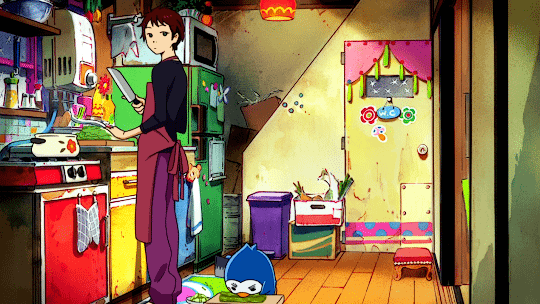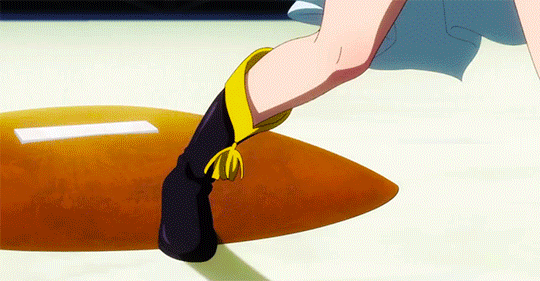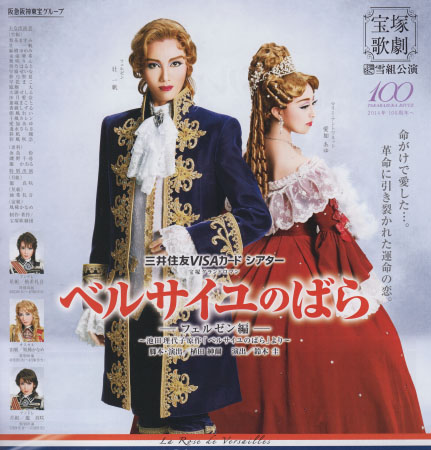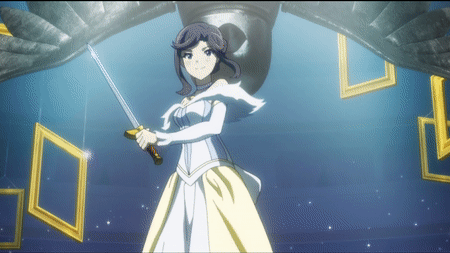originally posted at https://canmom.tumblr.com/post/675835...
Hi friends! Welcome to another Animation Night! This week I got asked about anime, and @the-descolada asked me about Shōjo☆Kageki Revue Starlight (少女☆歌劇 レヴュースタァライト), the ambitious 2018 anime directed by Kunihiko Ikuhara’s protege Tomohiro Furukawa.
Which reminded me… I’ve yet to watch last year’s RevStar movie! Well, this week’s Animation Night seemed like the perfect moment to remedy that, and also introduce you to the giraffe that has sat in my brain ever since I saw the anime… if at least one of you starts saying wakarimasu in a solemn tone of voice, I will have succeeded.

To see Revue Starlight in context, you need to know about two things: Kunihiko Ikuhara, and the Takarazuka Revue.
Let’s start with the first! A full account of Ikuhara’s fascinating career will have to wait for the day that we make him the focus of an Animation Night, but let’s see if we can cover the main points. Ikuhara is one of those distinctive, idiosyncratic auteurs that anime produces so well.
So, our boy Ikuhara got his start as a director on later seasons of Sailor Moon, and something of the experience must have given him a sense of the possibility of expression in the vocabulary of a limited-animation TV show in the tradition of Dezaki, particularly the repetition of ‘bank’ shots like a henshin [transformation, for the non-weebs in the audience] sequence. WikiMoon describes his tenure as being characterised by…
His signatures seem to be an offbeat sense of humor, like in episode 31; a refusal to shy away from themes others might feel too “dark” for a children’s show, as shown in episodes 46 and 110; and the use of a high number of frames per second for seemingly insignificant scenes, such as in episode 26 and the aforementioned episode 31.[1]

Following this, Ikuhara set out to make his defining work, Revolutionary Girl Utena (少女革命ウテナ Shōjo Kakumei Utena). On the surface, it’s a story about a group of students at a rather vaguely defined academy competing through duels to gain custody of a girl called Anthy, the “Rose Bride”, which will in turn grant the ‘power to revolutionise the world’ - a situation into which Utena, a girl obsessed with an image of being a heroic ‘Prince’ comes barrelling in, capturing Anthy almost immediately and spending the rest of the series fending off attackers. Each of these duellists is painfully trapped in a complex web of abusive relationships, and the episodes will introduce us to their stories to set up for the duel where they will be defeated by Utena and come to some kind of turning point in their arc. At around the midpoint of the show, Anthy’s rapist brother Akio enters the picture and things take an even darker turn. But it’s also packed with all sorts of weird goofy humour, like the episode where one character gradually transforms into a cow - it doesn’t stick and nobody mentions it again.
Utena, however, loves to convey this story very obliquely. It’s full of creative cinematography; plot developments will be conveyed by a Greek chorus of shadows on a wall, there are many repeated sequences with minor variations, important events will be conveyed with visual metaphors such as a car ride standing in for sexual assault. As such, its extremely devoted fandom have produced many books worth of intensive analysis, carried out by writers such as @empty-movement who are able to pick out the exact meaning of each colour difference in a framing rose. (The first time I watched it it went miles over my head because I was very stupid back then. Since I am now somewhat less stupid when it comes to film criticism, I am well overdue for a rewatch.)
Why so much about Utena? Well, it’s impossible not to see its influence in RevStar, because Utena takes a great deal of its imagery from the all-women musical theatre the Takarazuka Revue - but more on them in a bit!

Tomohiro Furukawa entered the picture on Ikuhara’s second major project, Mawaru Penguindrum, which obliquely took on the subject of the 1995 sarin gas attacks by the cult Aum Shinrikyo. It follows a group of effectively-orphaned kids whose parents were arrested as members of a similar cult who get drawn into the orbit of a supernatural entity - but as ever with Ikuhara, it’s full of things that can only be interpreted metaphorically, like the ‘child broiler’. This is where Ikuhara pioneered many of the elements that would become signatures of his later work, like presenting crowd scenes as extremely iconified, roadsign like figures, or the battle between the otters and the kappa (though only alluded to here).
Anyway, lest this become a full Ikuhara retrospective - and leave me nothing to write when I finally figure out how to cram an acceptably standalone selection of Ikuhara works into an Animation Night post! - let me bring in kVin to comment on Furukawa’s role in all this…
Who is that Furukawa fellow who’d get viewers so excited? If you had asked a few years ago, the answer would have been a fairly impressive action animator. Ever since Penguindrum, though, his name has carried more weight. Before that show, he’d never even drawn a storyboard, but Kunihiro Ikuhara sensed something in him. Furukawa ended up co-storyboarding the openings and up to 6 episodes in the second half, alongside some other rising stars like Shouko Nakamura, Mitsue Yamazaki, and Katsunori Shibata. All of them turned out to be exceptional creators in their own right (it’s time for my mandatory recommendation of Nakamura’s Doukyuusei), with identities of their own that are still very much influenced by their mentor; it lives on in Yamazaki’s framing and Nakamura’s thematic and design sense for example, even if the both of them have followed very different paths in the end.
─ Although Ikuhara’s style is of course not a miracle conjured from nothingness – it initially came down to his real-life theatrical inspirations plus endless Osamu Dezaki-isms filtered through Shigeyasu Yamauchi‘s lens and some Junichi Sato comedy – he’s always had this much of an inspiring effect on the youngsters who work under him. And, in modern times, no one has absorbed his precepts better than Furukawa, who’s actually become integral to Ikuhara’s working process. He assisted him on every one of his new projects, from minor stuff like his ending sequences on Kokoro Connect, BROTHERS CONFLICT, and NORN9, to acting as co-series director on Yurikuma Arashi.
So, Revue Starlight. This project came to life as many modern anime do as an original ‘multimedia project’ by entertainment company Bushiroad, opening with a stage musical and then the anime which would serve to promote more profitable media like manga and, inevitably, a gacha game. But this anime, handled by Kinema Citrus, was Furukawa’s chance to show what he had learned from Ikuhara.
So what’s it even about? RevStar is set in a performing arts school very similar to the one that trains performers for the Takarazuka Revue. The Takarazuka Revue is a venerable theatre troupe, founded in 1913 by a rich industrialist Ichizō Kobayashi. It is unusual for being entirely women, which - given that many of its major plays are romance works - means women playing male roles is a foundation to its whole design.
Kobayashi was a seriously conservative dude, and in his view, his Revue should train women to be traditional ‘good wives and mothers’ once they left the production, and the authorities of the system were strictly insistent that it was all for the stage and the Revue would tolerate no sort of lesbian funny business. As you can surely imagine, this did not stop the performers, or the fans (who are almost exclusively women) - Takarazuka quickly became understood as a lesbian symbol.

The performers of the revue are divided into two groups, the otokoyaku (男役) who play male roles and the musumeyaku (娘役) who play female roles. Students are trained in these roles from the second year onwards, from which point the otokoyaku cut their hair shorter and adopt masculine forms of speech. Further, within each of the five troupes in a given year, there is a top star - technically two, one otokoyaku, one musumeyaku, but the otokoyaku tends to be heavily prioritised and will be the one referred to the top star - who plays the main character in the performance, and tends to get the lion’s share of devotion and attention.
The Revue covers a great variety of theatre, but a lot of their works are Western, and they are particularly associated with their take on French noble costumes. It was also extensively influential on manga, with Osamu Tezuka growing up very near to Takarazuka. Here, we actually find a bit of a circular chain of influence: the revue influenced the wildly popular shōjo manga The Rose of Versailles, a story indirectly about the Japanese Left but set in the court of Versailles - and notably featuring the fictional Oscar, a woman raised as a boy who becomes captain of the Royal Guard. Takarazuka subsequently staged a number of adaptations of the manga, which became one of their most popular productions and cemented the both the otokoyaku/musumeyaku division and the ‘Top Star’ system in the 70s.
Here’s a poster from the 2013 production:

Naturally, there have been many times when Takarazuka performers have been in lesbian relationships, and sometimes settled down together after leaving the troupe - though this generally must be extremely clandestine since it is grounds for being fired from the Revue. In fact, the militaristic uniforms that became so iconic to the Revue’s image were originally an attempt to curb the rumours of lesbianism; performers were further forbidden from exchanging mail with their fans.
So, Revue Starlight. It is in large part a critique of the Takarazuka Revue - the Top Star system in particular. In addition to their daylight training for a first year production of a story called Starlight, which Emily Rand reads as a blend of The Rose of Versailles and Elizabeth, the girls compete regularly in secret duels on a hidden stage overseen by… a giraffe. The winner of this contest - the one who ‘shines brightest’ and is fit to be Top Star - we eventually learn will be granted the power to make a shine on whatever stage they desire - in effect a pretty open-ended wish. Everyone else? Well, it’s not clear at first… they all really want to be top star.
So, much like Utena, most episodes culminate in a duel, each character armed with a particular weapon. These duels are also occasion for each character to sing a duet, which forms the backdrop to their battle, as the stage contorts itself into symbolism for the relationships being contested. They’re spectacular, thanks in large part to the brilliant action animation of figures like Takushi Koide.
Unlike something like Utena, these hush-hush duels seem to be taking place in a much more mundane world - and though they keep fighting them, the girls also struggle to figure out why exactly there’s a talking giraffe.

Into this charged situation, enter Karen Aijo - who can’t see the logic of the Top Star system and doesn’t see why they can’t all shine on stage, and competes to this end. She’s joined by her childhood friend, Hikari, with whom she shared a promise (yep, it’s anime) to one day perform Starlight with her. And beyond that is a large cast of other ambitious young performers; outside of the duels, the show takes on a kind of tone of lightly comedic, slice of life school story, with enough drama to come out on the secret giraffe stage. (Oh and yeah they’re like… pretty much all gay. It’s fully yuri. How could it not be though really?)
I won’t spoil where it goes, since we’re about to watch it, but it’s a compelling, suitably high-drama arc with some really spectacular animation along the way - and the movie looks like it will be even more so. So, if you will, come and enjoy a delightful opening of what we may hopefully one day call the ‘Ikuhara school’ of symbolism-drenched lesbian anime.
Animation Night 92 will be starting shortly at our usual place - https://twitch.tv/canmom ! We’ll watch the original RevStar series followed by the movie. I’d love to power through it all in one go, but we might end up splitting like we did last week, because it’s not a short programme. Still, for however much we manage tonight, I hope you’ll come join~
Comments